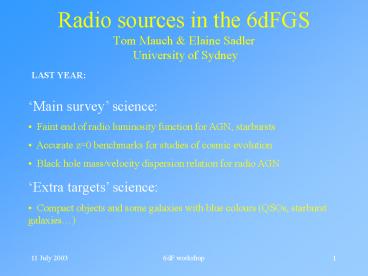Radio sources in the 6dFGS Tom Mauch - PowerPoint PPT Presentation
1 / 18
Title:
Radio sources in the 6dFGS Tom Mauch
Description:
Compact objects and some galaxies with blue colours (QSOs, ... Stellar objects (foreground stars, QSOs, compact galaxies) Blue galaxies (starburst, AGN) ... – PowerPoint PPT presentation
Number of Views:24
Avg rating:3.0/5.0
Title: Radio sources in the 6dFGS Tom Mauch
1
Radio sources in the 6dFGS Tom Mauch
Elaine Sadler University of Sydney
LAST YEAR
- Main survey science
- Faint end of radio luminosity function for AGN,
starbursts - Accurate z0 benchmarks for studies of cosmic
evolution - Black hole mass/velocity dispersion relation
for radio AGN - Extra targets science
- Compact objects and some galaxies with blue
colours (QSOs, starburst galaxies)
2
All-sky radio continuum surveys
NVSS (Condon et al. 1998) n 1.4 GHz
dec 90o to -40o
SUMSS (Bock et al. 1999 Mauch et al. 2003) n
843 MHz dec -30o to
-90o Currently almost 85 complete (though not
catalogued), will be finished by Dec 2003 Both
surveys have 45 beam, 3-6 mJy det. limit,
position accuracy 1-2
3
Since Last Year
- 6 of 6dFGS galaxies in initial data release
are detected as radio sources. - 909 Radio sources in 14880 galaxies.
- 394 Additional Target spectra.
- All spectra eyeballed and classified.
- Initial database of radio detections with
multiwavelength data.
4
The Database
Convenient method for searching large dataset!
5
Radio sources in the main survey
- 909 radio sources out of 14880 total objects
- 6 Detection Rate!
- Possibly because of our 10 radio optical
separation cutoff. - All spectra hand classified (star,Aa,Ae,Aae,SF)
- 399 AGN
- 436 Star-Forming
- 71 Unclassifiable
- 3 Stars
- About 50/50 split between AGN and SF in 6dFGS
- (60/40 in 2dFGS)
6
Typical Spectra of Faint radio Sources in 6dFGS
(1)
- Absorption line AGN
7
Typical Spectra of Faint radio Sources in 6dFGS
(2)
- Emission Line AGN
8
Typical Spectra of Faint radio Sources in 6dFGS
(3)
- Star Forming Galaxies IRAS Source
- 0.28 Jy at 60mm
Large fraction of SF galaxies interacting.
9
Redshift distribution of 6dFGRS radio sources
2dF Sample
6dF Sample
10
Radio emission from star-forming galaxies
6dFGS-NVSS
2dFGS-NVSS
Many faint (lt5mJy) NVSS sources with no IRAS
detection.
11
Local radio luminosity function of active and
star-forming galaxies
Distribution of AGN radio luminosities.
Low-luminosity AGN are hard to find
12
6dFGS Additional targets
- 6dFGS unallocated fibres placed on NVSS/SUMSS
radio IDs which have bJlt18 mag but which are not
in the main sample - 394 objects in initial data release.
- Stellar objects (foreground stars, QSOs, compact
galaxies) - Blue galaxies (starburst, AGN)
- What fraction of the local radio-source
population is missed because hosts appear
stellar? Dont need all objects observed, just a
sub-sample - i.e. flexible
13
Detection fractions of additional targets
- Many additional targets are in other additional
target samples, large fraction have been
observed! - 166 stars
- 61 AGN
- 74 Star Forming
- 93 Unknown
About same fraction as in main survey! Possible
BL-Lac population.
14
Redshift Distribution of Additional Target
Galaxies
- Median z0.08
- Fainter sources
- Emission line AGN
- Starburst galaxies
15
Some interesting Additional Targets (1)
- QSO- No previously recorded redshift.
- Bright radio source (1.8 Jy in NVSS) also PKS
1955-35
16
Some interesting Additional Targets (2)
- Higher-z QSO (4.9 mJy at 1.4 MHz)
- Incorrect z from runz actual z is 0.75
MgII
17
Some interesting Additional Targets (3)
- Starburst Galaxy (ULIRG?)
- 43.5 mJy at 1.4 GHz (1024.5 W Hz-1) 0.189 Jy at
60mm
18
Some interesting Additional Targets (4)
- Radio emission from white dwarfs?
- Willes Wu 2003 (astro-ph/0302583) claim white
dwarf pairs can be strong radio sources! - 2.9 mJy radio source.
- 3 found in current sample.
- Only 0.1 per deg2 and 10 of these could be radio
sources. - Class 2 in the initial data release, but class 4
spectrum!































